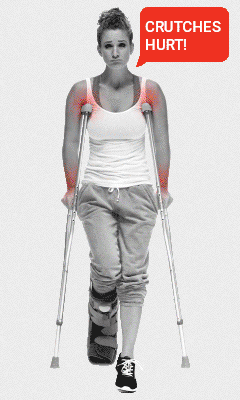Lower Leg Injury Resource Center
Lisfranc Injury
Surgery, Treatment & Recovery Time
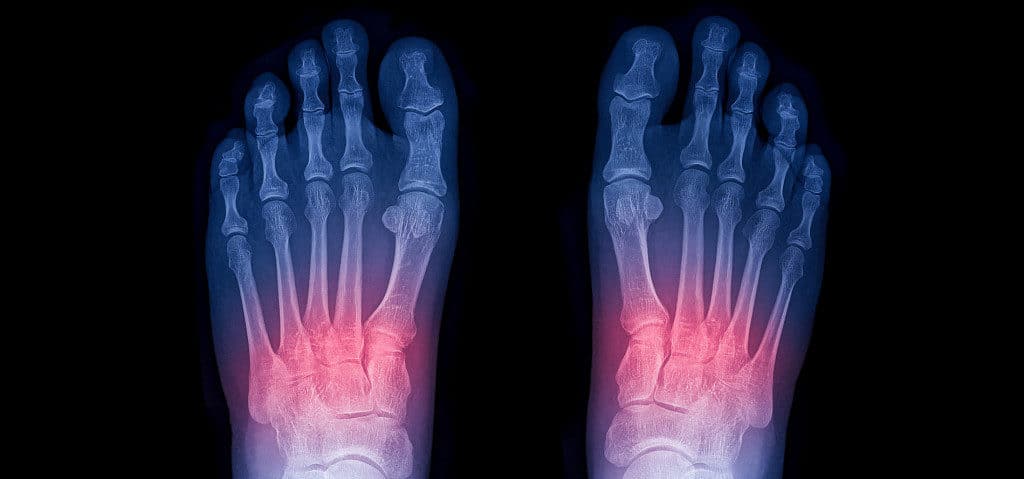
A Lisfranc injury happens when the ligaments or bones in the middle of your foot are fractured, sprained or dislocated. If often requires surgery and can take three to six months to heal. A Lisfranc injury can be simple or complex depending on how many bones or joints are affected, and treatments vary depending on severity.
The following article details types of Lisfranc injuries, treatment options and what to expect during recovery.
I
WHAT IS A LISFRANC INJURY?
A Lisfranc injury affects the bones or ligaments in the middle of your foot, roughly over your foot’s arch. The Lisfranc joint is where the metatarsal bones of your midfoot and the tarsal bones around your ankle and heel are connected by a tough band of tissue. It’s a pretty complex joint that plays a crucial biomechanical role, so it’s imperative that a Lisfranc injury is diagnosed and treated correctly. The joint helps to both stabilize your arch and maintain proper foot alignment. In other words, it plays a key role in standing, walking, running and jumping.
The three primary types of Lisfranc injuries are sprains, fractures and dislocations, and in some cases an injury can be a combination of all three. It can affect one or more of the foot’s bones and ligaments at the same time. Severity and complexity will determine the type of treatment and recovery plan you’ll need.

The injury gets its name from the pioneering French surgeon Jacques Lisfranc de St. Martin. He noticed it was common among soldiers in Napoleon’s army who’d fallen from a horse with a foot stuck in a stirrup.
I
IS A LISFRANC INJURY RARE?
Only one in about every 60,000 people per year is diagnosed with a Lisfranc injury, so they’re pretty rare and often misdiagnosed as a simple sprain. When this happens people sometimes try to treat them at home by “walking them off.” It’s extremely important, however, to receive a proper evaluation from a doctor because Lisfranc injuries can be very serious and commonly require surgery.
I
CAUSES OF A LISFRANC INJURY
Lisfranc injuries frequently happen during athletic activities and are a bit more common among soccer and football players than other sports. Many elite athletes have seen promising seasons end abruptly because of a Lisfranc injury. Lisfranc sprains, strains and fractures can also be the result of simple twists or falls, a large object falling on your foot or a major trauma like a car accident.

I
LISFRANC INJURY SYMPTOMS & DIAGNOSIS
The most common symptoms of a Lisfranc injury are:
- Bruising on the bottom of the foot (highly indicative of a Lisfranc injury)
- Bruising or blistering on the arch of the foot
- Swelling of the foot
- Pain throughout the foot, especially when pressure is applied
- Being unable to bear any weight
- Abnormal widening of the foot
These can be symptoms of less serious injuries, too, but it’s important to have a proper evaluation by a doctor. If rest, ice and elevating your foot don’t reduce the pain or swelling within a day or two you may have a Lisfranc injury, so make sure to see a doctor as promptly as possible..
What does a Lisfranc injury feel like?
The level of pain or discomfort you experience from a Lisfranc injury depends on the severity of your injury. Some people experience immediate intense pain and can’t weight their foot at all. Some describe it like a sprain that doesn’t get better after a few days—one of the reasons it’s often misdiagnosed at first.
A Lisfranc injury compromises your foot’s ability to carry weight over the arch, so if you find yourself standing on the outside of your foot to avoid pain in the arch area, this is a potential red flag.
Key indicators are persistent pain, swelling and bruising—particularly bruising of the bottom of the foot under the arch. If in doubt, see a doctor..
Diagnosing a Lisfranc injury
If your doctor suspects a fracture or tear in your Lisfranc joint, they’ll examine your foot and send you for X-rays. An unweighted X-ray will show a broken or dislocated bone in the midfoot but may not show a ligament tear or rupture. Weighted X-rays can reveal a compromised Lisfranc ligament. In addition to X-rays, you may also need an MRI or CT scan to confirm the injury and determine its severity.
I
TREATMENT FOR A LISFRANC INJURY
Non-Surgical Treatment
Your treatment plan will depend on the severity of your injury. Treatment for a minor Lisfranc injury (where you haven’t broken a bone or torn a ligament) is similar to that for a sprained ankle – rest, ice and elevation. This will help manage the pain and swelling of your foot while it heals. Over-the-counter non-steroidal anti-inflammatory medications (NSAIDs) like Ibuprofen can help reduce pain and inflammation during this time.
Healing from a Lisfranc injury may also require a non-weight-bearing period of about six weeks when your foot will be placed in a cast or walking boot. This rest period for your foot is a crucial step in your recovery from a Lisfranc injury and shouldn’t be taken lightly.
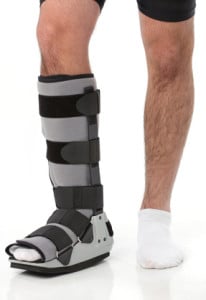
If your doctor asks you to not to put weight on the affected foot for a few weeks you’ll need traditional crutches or a crutch alternative such as a knee scooter or iWALK crutch (a crutch alternative that allows you to stand and walk hands free and maintain day-to-day activity while keeping your foot elevated).
Once the swelling and pain has subsided and you’ve got clearance from your doctor you’ll be able to start gradually bearing weight again until you can walk unaided. Physical therapy is usually the final phase of a Lisfranc injury treatment plan. Be sure to wear supportive footwear, possibly with custom insoles, to ensure that your arch is supported as your foot slowly recovers its stabilizing strength.
Surgical Treatment
More severe Lisfranc injuries are the result of fractured or dislocated bones, or torn ligaments and may require surgery. The goal of surgery is to realign bones and repair ligament tears. There are two primary types of Lisfrnac injury surgery: internal fixation and fusion.
Open Reduction Internal Fixation:
This is a traditional orthopedic surgery for which your surgeon will use plates, screws, Fibertape or other hardware to hold your bones in place. Depending on your surgeon’s preferred method, the inserted hardware may be temporary, which means a second surgery will be needed to remove it after a few months.
Fusion:
With fusion surgery, the bones will be welded or fused into place to form a single solid piece. Any fusing material will become a permanent part of the foot’s structure.
Studies have been inconsistent on the benefits of open reduction and internal fixation (ORIF) versus fusion surgery. A study by University of Minnesota researchers found fusion may provide better long-term pain relief. Nicholas J. Bevilacqua, an orthopedic specialist, wrote in Podiatry Today that fusion offers more stable, predictable outcomes..
I
LISFRANC SURGERY RECOVERY TIME & REHABILITATION
How long does it take to recover from Lisfranc injury?
Lisfranc injury can be quite serious and require months to heal. For those experiencing strains or sprains, recovery could take six to eight weeks. For those needing surgery, recovery will likely take three to five months.
As with any injury, following your doctor’s recommendations is an essential part of the recovery process. The recovery regimen will vary from one case to the next, but is likely to involve the following steps:

- Rest, ice, and elevating the foot will help reduce swelling and allow the body to recover more quickly.
- Staying off your foot entirely for an extended period (generally six to eight weeks) will give the foot time to recover.
- Avoiding high impact activities will be integral to recovery and take three to five months after surgery. It’s important to seek your doctor’s blessing before stressing the foot in a way that could compromise the healing process.
I
CAN YOU WALK WITH A LISFRANC INJURY?
If you’re recovering from a Lisfranc injury, your doctor is going to ask you to stay off your injured foot for a month or more. This can be challenging for active people, but if you want to make a full recovery it’s an imperative part of the process.
To help you get around during this time, you’ll need a mobility device. There are a few to choose from, including traditional crutches, knee scooters and hands-free crutches.
Traditional Crutches
Crutches are used by millions of people worldwide each year. They’ve been around for thousands of years, and most people assume they’re the only option available. Our crutch resource center has more information about the pros and cons of crutches.
While crutches can be a useful, quick-fix solution they can also be restrictive because they limit the use of your hands and arms and are physically exhausting. If you’re used to being active and you’re dreading the thought of hobbling around for six weeks or more, you may want to consider another option.
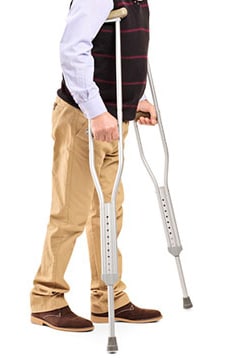
Knee Scooters or Knee Walkers
Crutch alternatives like knee scooters (aka knee walkers) are becoming more popular. A knee scooter has a handlebar, wheels and a platform on which to kneel. Knee scooters are great for flat surfaces but can’t be used on uneven ground or stairs. They are fairly bulky, which makes them tricky to transport. As with crutches, they require use of your hands while on the move.
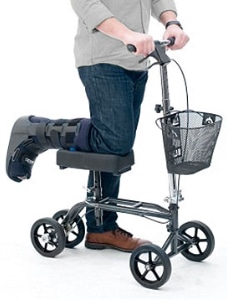
iWALK Hands-Free Crutch
Another alternative is the iWALK hands-free crutch. It functions like a prosthetic leg which means that you can walk around unaided and with the full use of your hands and arms. Meanwhile your knee is resting safely on a padded platform. The iWALK crutch is lightweight and can be used on uneven ground, stairs and even in the shower.
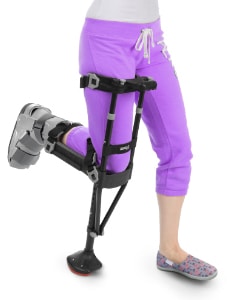
I
SUMMARY
A Lisfranc injury is rare and often misdiagnosed, but it’s something to take very seriously. While it’s easy to miss-diagnose, it’s tough to rehabilitate and can take months to make a full recovery. During this time, be sure to rest and listen to your doctor’s instructions. Understanding your injury, its severity, treatment options and your rehabilitation plan are your keys to the fastest recovery.
The information above is intended for informational purposes only and is not intended to prevent, treat, or diagnose any illness or disease. We aim to provide the highest quality information, so if you have any questions on the information above, we welcome your feedback!
I
RESOURCES
- Wedro, Benjamin, MD, and Melissa C. Stoppler, MD. “Lisfranc Fracture Causes, Symptoms – MedicineNet.com.” MedicineNet. N.p., n.d. Web. 8 Feb. 2014. http://www.medicinenet.com/lisfranc_fracture/views.htm
- “Lisfranc (Mid foot) Injury-OrthoInfo – AAOS.” Lisfranc (Midfoot) Injury-OrthoInfo – AAOS. N.p., n.d. Web. 9 Feb. 2014. http://orthoinfo.aaos.org/topic.cfm?topic=A00162
- “Lisfranc (Mid foot) Sprain/Fracture.” Lisfranc (Midfoot) Sprain/Fracture. N.p., n.d. Web. 9 Feb. 2014. https://www.aofas.org/footcaremd/conditions/ailments-of-the-midfoot/Pages/Lisfranc-Injury.aspx
- “Foot Health Facts – Lisfranc Injuries.” American Colege of Foot and Ankle Surgeons. http://www.foothealthfacts.org/footankleinfo/lisfranc_injuries.htm

